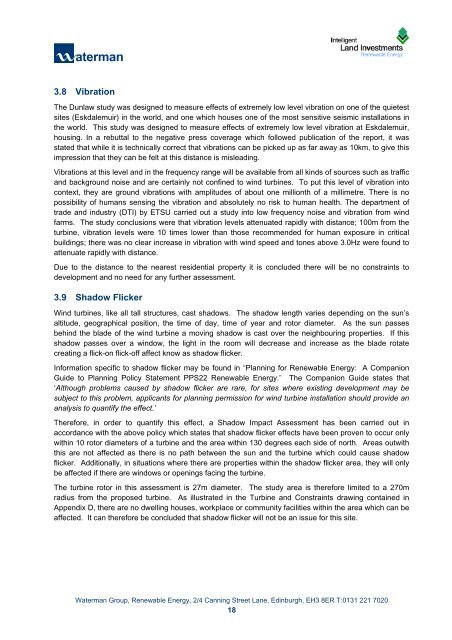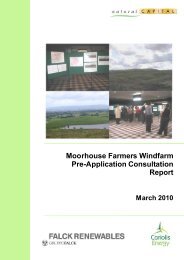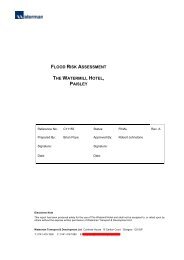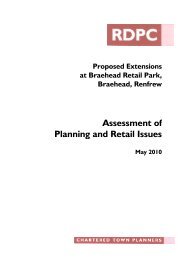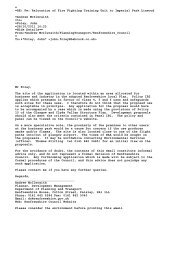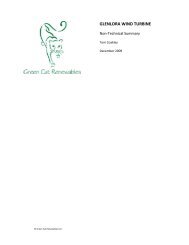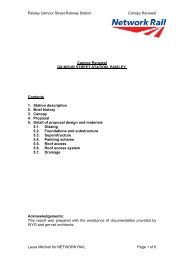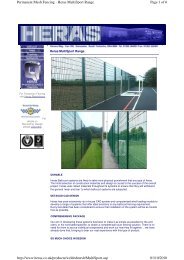Supporting Documentation - Renfrewshire Council
Supporting Documentation - Renfrewshire Council
Supporting Documentation - Renfrewshire Council
You also want an ePaper? Increase the reach of your titles
YUMPU automatically turns print PDFs into web optimized ePapers that Google loves.
3.8 Vibration<br />
The Dunlaw study was designed to measure effects of extremely low level vibration on one of the quietest<br />
sites (Eskdalemuir) in the world, and one which houses one of the most sensitive seismic installations in<br />
the world. This study was designed to measure effects of extremely low level vibration at Eskdalemuir,<br />
housing. In a rebuttal to the negative press coverage which followed publication of the report, it was<br />
stated that while it is technically correct that vibrations can be picked up as far away as 10km, to give this<br />
impression that they can be felt at this distance is misleading.<br />
Vibrations at this level and in the frequency range will be available from all kinds of sources such as traffic<br />
and background noise and are certainly not confined to wind turbines. To put this level of vibration into<br />
context, they are ground vibrations with amplitudes of about one millionth of a millimetre. There is no<br />
possibility of humans sensing the vibration and absolutely no risk to human health. The department of<br />
trade and industry (DTI) by ETSU carried out a study into low frequency noise and vibration from wind<br />
farms. The study conclusions were that vibration levels attenuated rapidly with distance; 100m from the<br />
turbine, vibration levels were 10 times lower than those recommended for human exposure in critical<br />
buildings; there was no clear increase in vibration with wind speed and tones above 3.0Hz were found to<br />
attenuate rapidly with distance.<br />
Due to the distance to the nearest residential property it is concluded there will be no constraints to<br />
development and no need for any further assessment.<br />
3.9 Shadow Flicker<br />
Wind turbines, like all tall structures, cast shadows. The shadow length varies depending on the sun’s<br />
altitude, geographical position, the time of day, time of year and rotor diameter. As the sun passes<br />
behind the blade of the wind turbine a moving shadow is cast over the neighbouring properties. If this<br />
shadow passes over a window, the light in the room will decrease and increase as the blade rotate<br />
creating a flick-on flick-off affect know as shadow flicker.<br />
Information specific to shadow flicker may be found in “Planning for Renewable Energy: A Companion<br />
Guide to Planning Policy Statement PPS22 Renewable Energy.” The Companion Guide states that<br />
‘Although problems caused by shadow flicker are rare, for sites where existing development may be<br />
subject to this problem, applicants for planning permission for wind turbine installation should provide an<br />
analysis to quantify the effect.’<br />
Therefore, in order to quantify this effect, a Shadow Impact Assessment has been carried out in<br />
accordance with the above policy which states that shadow flicker effects have been proven to occur only<br />
within 10 rotor diameters of a turbine and the area within 130 degrees each side of north. Areas outwith<br />
this are not affected as there is no path between the sun and the turbine which could cause shadow<br />
flicker. Additionally, in situations where there are properties within the shadow flicker area, they will only<br />
be affected if there are windows or openings facing the turbine.<br />
The turbine rotor in this assessment is 27m diameter. The study area is therefore limited to a 270m<br />
radius from the proposed turbine. As illustrated in the Turbine and Constraints drawing contained in<br />
Appendix D, there are no dwelling houses, workplace or community facilities within the area which can be<br />
affected. It can therefore be concluded that shadow flicker will not be an issue for this site.<br />
Waterman Group, Renewable Energy, 2/4 Canning Street Lane, Edinburgh, EH3 8ER T:0131 221 7020<br />
18<br />
K:\Projects\CIV12920_ILI Windfarms_Batch 7\CIV12920_XXX_Hartfield<br />
Farm\Documents\Reports\CIV12920_1202xx_Hartfield_<strong>Supporting</strong> Turbine Assessment_225kW.docx


